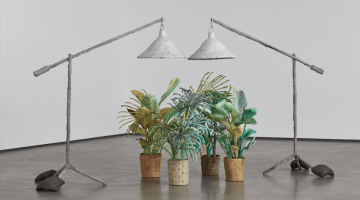When a fictional sci-fi future comes into mind the surroundings are likely to be one of two-pronged possibilities: is it a mechanically pristine, totalitarian robotic regime of Orwell’s “1984?” Or, a raucous, dry, resourcefully constructed, tonal “Mad Max” landscape? What would artifacts from these parallel places be? “CULM,” now up at Night Gallery through September, is an expedition into the present, denying our predisposition to see just these viewpoints. Curators Sayre Gomez and J. Patrick Walsh 3, present the works as aesthetic artifacts from a vortex that “goes back and forward through time.” Tracing this dimensional void to Chur, an antiquated town, whose existence you may or may not know is near the Rhine River in the Valleys and Swells of Switzerland. The blemish on this crisp landscape is the anthracite mine waste (culm), whose mineral luminosity has built itself into a slowed trudge of black viscosity. As the press release notes, “Empty black cells fill the veins between the past and future, providing unusable black fuel to the industrial intestines which stand in for the here and now.” The outlook is undeniably (and self described) “dystopian,” the work itself, however, exists beyond this pessimistic plane.
It must be said here, the spectacular square footage of Night Gallery, further facilitates the gravitas of “CULM.” As patrons wonder through every artist is given a personal sphere to exist. Honing in and stepping back, the relationship of each piece within its own context and as a part of a whole help create a cohesiveness that is rare, underestimated and refreshing. Upon entering Curator J. Patrick Walsh 3 assemblage, “Hot Pot Churner (Espresso Oil), 2013,” tumbles from the ceiling, a cascade of coffee, motor oil, aluminum cast and wax. The objects are at once dense yet light. It is the materiality of this piece that sets the tone and texture throughout. Likewise, this in-between state is reflected within fellow Curator’s Sayre Gomez panels. Each painting has elusive shapes existing just beneath the surface: a combination of non-black, non-blue and non-red. Hues your eye recognizes yet cannot aptly compartmentalize. This characteristic defines each respective work within “CULM,” in one manner or another. The pieces are recognizable within its efforts; yet, command an evolved presence of whatever motive is at play.
Math Bass’s two torso-less leg sculptures (both respectively titled), “Untitled (Brutal Set, performance remnant), 2013,” are concrete casts of a jean short and a more traditional denim pant. These inverted legs, constructed of concrete, defy the weight of their existence. A medium reconfigured, divulging the delicacy of this substance’s physical capabilities. A matter primarily site specific (in a utilitarian sense) can flow upward and (within reason of most inanimate objects), be transportable. Similarly enigmatic is Gavin Kenyon’s “Untitled, 2013.” Fleshy and anthropomorphic is this wall affixed bulbous creation, with a thick curl of a tail molded to its base. Staring intently at this amalgam of smooth and rough, one half hopes (and expects) this furry tail to swing to the tick of a second hand, like a wall clock. The combination of textures (noted as dyed plaster and fur) crescendo into what you may imagine to be a future primitive figurine for idolatry. If Kenyon’s contribution is the futures figurine of idol, then Kaari Upson’s “Foot on Throat, 2013,” must also be anointed into this sainthood, as well. Here too, the texture feigns familiarity. A gaseous rosy magenta is protected by a cloudy exoskeleton of translucent silicon. Long ago hardened seams, divots and wrinkles mar the surface. “Foot on Throat,” is an indefinable petrified object protecting a dance of color below.
As each assemblage featured in “CULM” re-evaluates materiality and the identity of such, so too does the paintings (or those approaching this medium). Ryan Foerster’s, “Hurricane (Shawn), 2006-2013,” and “Hurricane (Julie shower), 2006-2012,” hang side-by-side two panels all tumult and color. The erosive C-print with detritus doting the surface seems to be more beautiful then the image that once existed in its entirety, just below the surface are amoeba like shapes, mesmerizing and frustrating. The fleeting subjects leaves you wishing that you could reach in and pull the indefinable shape out. Sam Moyer’s “91607, 2013,” is a repetitive series of horizons. Here, the shadowy fronts reiterate the dystopian future that “CULM” portrays. This linear trifecta divides the surface with wispy ink, forecasting an industrial snowy existence. Here, the opposing visions of the future weave into one.
For more information visit here.
-Contributed by Bianca Guillen





